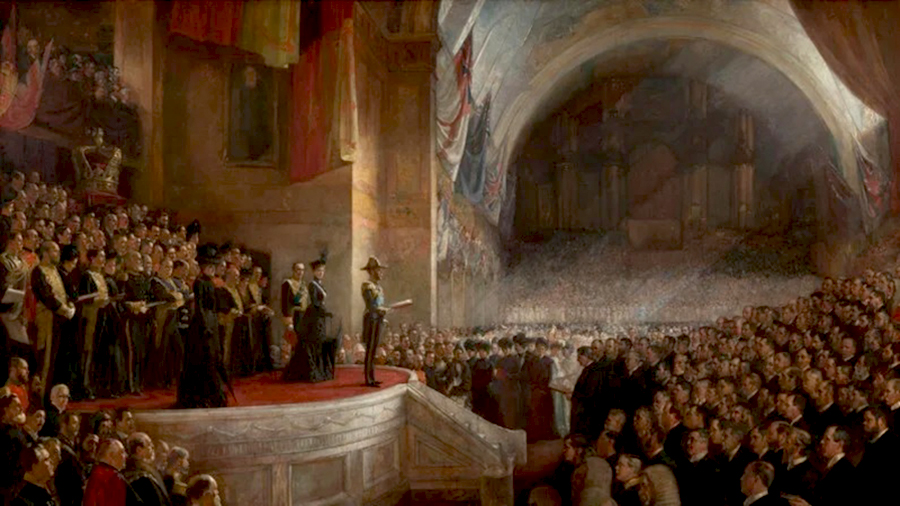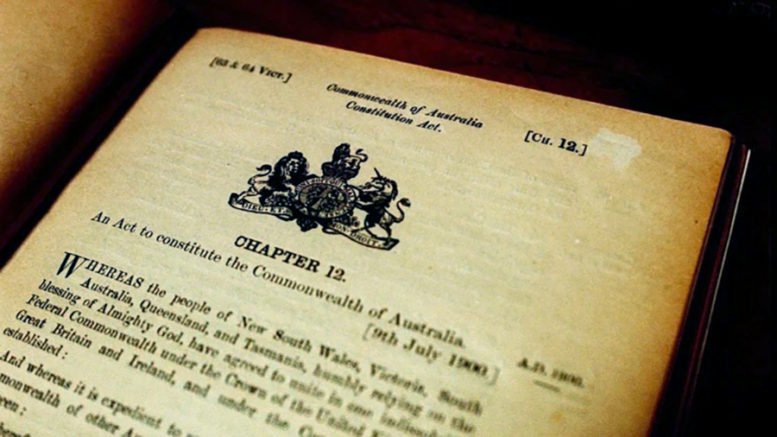Contributed by Glen Davis
The Australian Constitution is the founding document of the Australian nation, providing the primary source of our laws as well as determining the power of all three branches of governance: The Parliament, the Executive, and the Courts.
Australia as we’ve known it, didn’t exist until six separate British colonies came together on 1 January 1901. The Constitution, the Federation of Australia, commenced after this.

Tom Robert’s painting of First Parliament of the Commonwealth of Australia on 9 May 1901
When the Australian Constitution was written humans had never flown, two World Wars were something people may have imagined in their nightmares, while technology like smart phones and computers were beyond the realms of people’s understandings. Yet the Constitution remains pretty much the same as when it was written.
Changes to the Constitution are difficult. First the two houses of Australia’s Parliament must give an absolute majority. Following this a successful vote in a referendum allows a change to the constitution. It needs a nationwide majority of votes, and four of the six states, to approve any changes. NSW and Victoria, the states with the biggest populations must also have a majority. But they cannot decide the outcome alone.
The constitution was devised through a series of conferences, conventions at the end of the nineteenth century.
Alfred Deakin and Charles Kingston argued that a referendum was the best way for the colonies to make a decision. This was agreed to for a while and was radical proposal for its time. Only Switzerland and the United States used this method before.
In 1891, the Constitutional Convention rejected the referendum proposal.
Throughout the next few years those devising our Constitution argued and debated the document and its necessary safeguards. Even when it was agreed a referendum would be the mechanism to make changes it was determined change was never an easy option.
Tasmanian Premier Sir Edward Braddon was blatant, stating that it should be made as difficult as possible to amend the Constitution:” He wasn’t kidding.
Five times; 1937, twice in 1946, then 1977, also 1984 a majority of Australian voted for changes to the Constitution, but the majority of states did not vote for change. Thus, it was defeated.
Of the seven changes made to the Constitution, six saw the states vote 6-0, the other saw the states vote 5-1 over the issue of state debts in 1910. In all cases of Constitutional change, the majority of Australian voted for change.
One important referendum which was defeated in all states, 6-0, and received only 37 percent of the vote was the 1988 Fair Election referendum. The aim of this was to enshrine the one vote, one value principle.
An Australia wide campaign by the Liberal-National Parties to oppose the referendum, meant it had next to no chance of success.
It’s worth noting that though 86 percent of Australians live in the big cities. National Party votes in rural Australia have a value of 20 over over votes submitted in the cities.
No successful changes have been made to the Constitution since 1977.
As we move into the third decade of the 21st Century, how relevant is the constitution? What, if any changes are required, for the Constitution to reflect contemporary Australia?
Australia does not have a Bill of Rights. There’s the fact the first Australians who have been here for 60,000 years don’t get mentioned. We know in other Commonwealth countries such as Canada they’ve amended their constitution in 1982, then again in 1983, to recognise indigenous rights. Discussion of including Australia’s First Nations people in the Constitution preamble has been shelved.

Photo by Dave Hunt/AAP: First Nations must be included in an Australian constitution
However, the constitution includes reference to phasing out state tariffs, the salaries paid to MPs’ s at the time of Federation but is silent on the role of Prime Minister and Cabinet. Australia is a federation of states and territoiries, But this is not mentioned at all in the Constitution.
Surely, in 2021 the people of Australia deserve a Constitution reflecting not just contemporary Australia, but the Australia we want to have?
To make changes we need a process that doesn’t hinder/block change. Some basic changes could be achieved, not by undertaking a referendum, but possibly, by achieving a two thirds majority in both houses of Federal Parliament, like Germany has. I don’t know if that’s perfect, but happy hearing of other proposals.


Be the first to comment on "Australia needs a new constitution to meet the needs of the day"